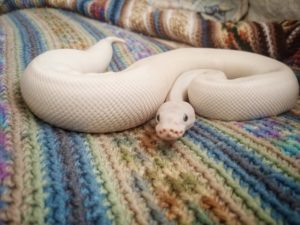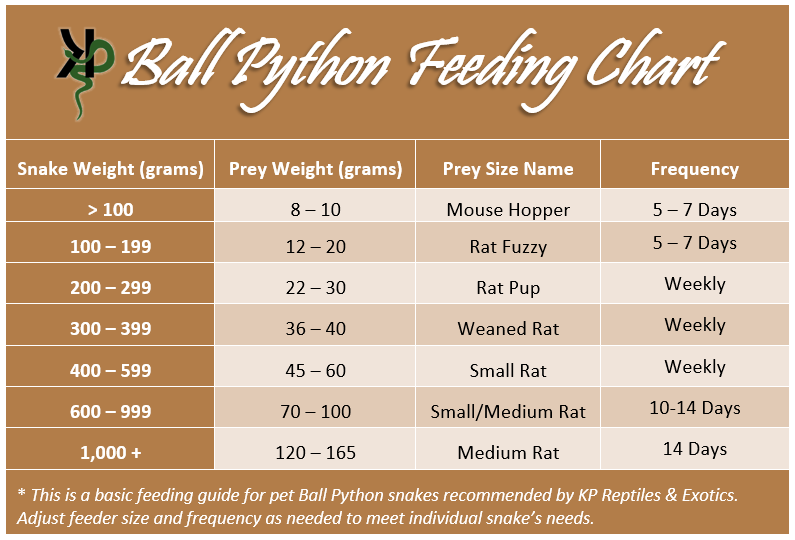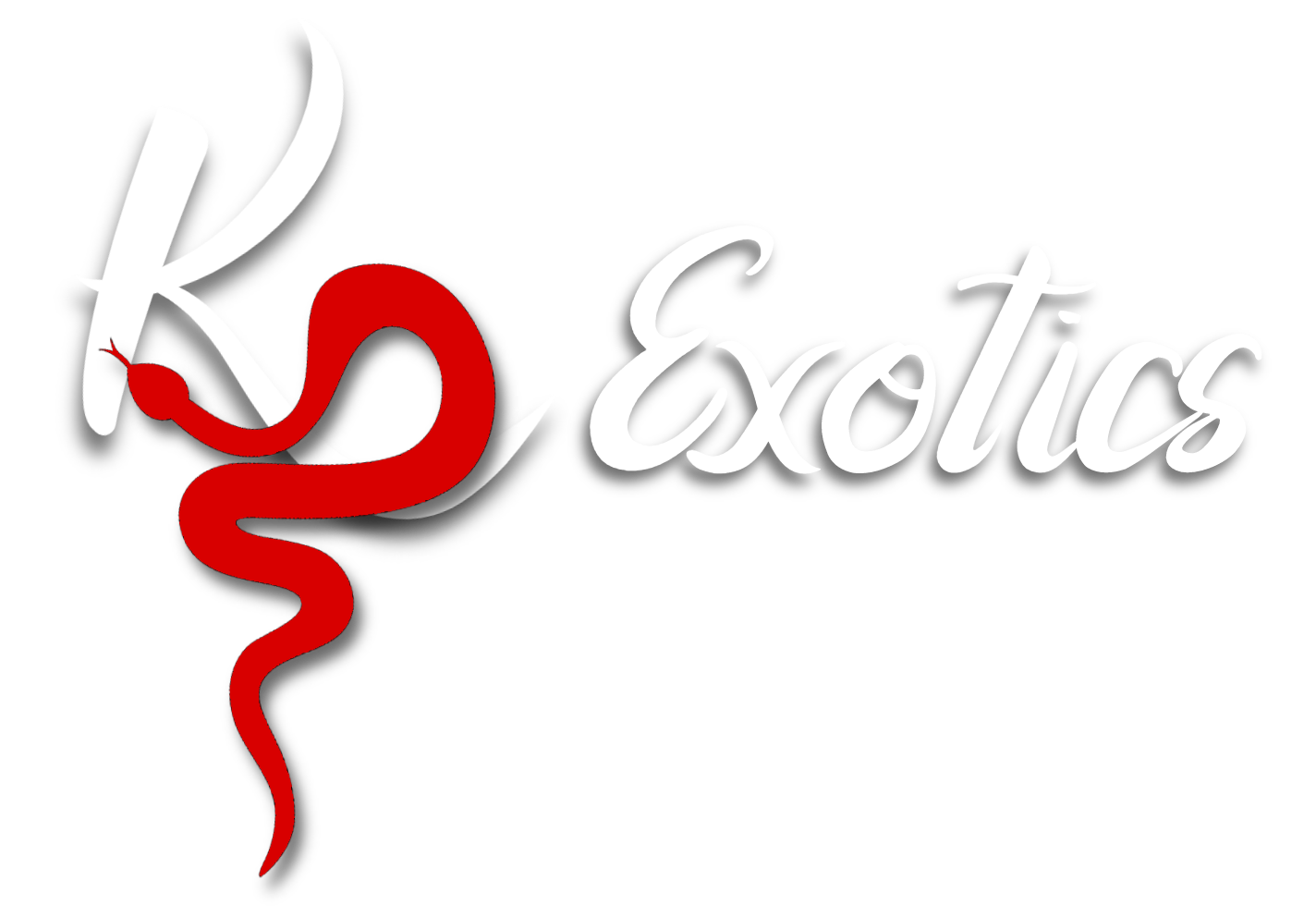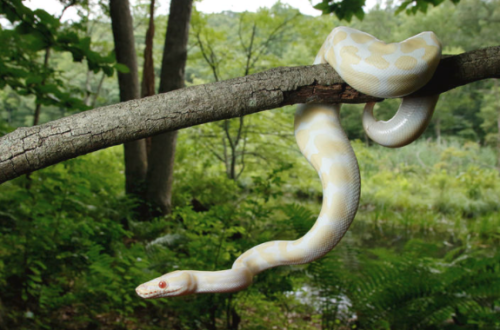FEEDING & HOUSING YOUR BALL PYTHON

We have gotten several snakes in as rescues that wouldn’t eat due to poor husbandry advice. Some of our clients and friends have reported bad advice from pet stores when buying feeders. Most experienced reptile keepers know you shouldn’t listen to pet store workers’ advice when it comes to, well, anything. Even the smaller stores are known to give poor advice. So, we made this post for anyone who keeps or is interested in keeping ball pythons, one of the most common pet snakes in Arkansas.
FEEDING
First and foremost, your young BP should be started on rats ASAP. Many breeders will start their hatchlings on rat fuzzies from the get-go to avoid any issues. BPs are known to be picky and feeding them mice can often lead to them getting hooked on mice. This isn’t an issue until your BP gets bigger and a single mouse is no longer enough food for them.
Feeding schedule: You should feed baby BPs, less than 4 months old, every 5-7 days. Juvenile snakes should be feed weekly. Sub-Adult and Adult size snakes should be fed every 10-14 days.
Feeding sizes: You need a digital kitchen scale to weigh your snake and your snake’s food. Weigh your snake monthly to track gain, preferably “empty” before feeding and after a good poo.
A growing BP should be getting a single prey item that is 10-15% of their body weight. If your baby BP weighs 100 grams, then you want their food to weigh 10-15 grams, which would be a small fuzzy rat.
Once your snake gets to be sub-adult size, 8-10% of their body weight is plenty and you can feed less often. So if your 2 yr old male BP weighs 700 grams, he should be getting a 60-70-gram meal, which is a small rat, every 10-14 days.
Adult BPs should be fed a meal that keeps them at a healthy weight. Big females over 1500 grams should get medium rats (100-200 grams). Males are usually fine on small rats or small/medium sizes (50-100 grams). You’re trying to maintain their size, not gain at this point. Most adults will maintain their weight being fed every 2 weeks. If you prefer to feed weekly, go down a size in prey. Fat snakes can have health problems or be more prone to illness.

HOUSING
Ball pythons are shy crepuscular snakes. They venture out around dawn and dusk, avoiding other animals larger than they are. They like dark, quiet places where they feel safe from predators and exposure. Being from Sub-Saharan Africa, they need it hot (85-88 degrees on the warm side) and moderately humid (55-70%). Your cool side should not dip below 75-78 degrees. All of this means that glass tank snake kit you bought from Petco is not going to work well…
At KP we recommend keeping your Ball Python in a rack system or PVC (or well-sealed wood) snake enclosure. Both are much easier to maintain steady temps and humidity. They also take up less room, are lightweight, and are easier to clean. PVC enclosures can be stacked right on top of each other!
 If you have varying sizes of snakes, a combo rack is a great investment. This one from Herptastic Reptiles holds two different size tubs to allow you to house all of your ball pythons in the same rack.
If you have varying sizes of snakes, a combo rack is a great investment. This one from Herptastic Reptiles holds two different size tubs to allow you to house all of your ball pythons in the same rack.
https://www.herptasticreptiles.com/product-page/15-32-1-tall
Or if you prefer your snakes to have more room, the tubs for this rack will be comfortable for even the largest females. Add a couple of hides for smaller snakes to feel safe and secure.
https://www.herptasticreptiles.com/product-page/41-qt-cb70-1-tall
If you have just one or two snakes or prefer to have a nice set up for you to look at, a PVC enclosure is a great option. A 3×2′ Ball Box from Herptastic would be perfect for most Ball Pythons. Only very large females would need the next size up, a 4×2. An enclosure that is 12″ tall is more than adequate though 15-18″ tall will give you some room to decorate or add live plants.
https://www.herptasticreptiles.com/product-page/ball-box-36-cage
There are other sellers of PVC enclosures if you want to shop around. ReptileBasics.com has some good ones as does Vision, TGR, and Brace Exotics. Just be sure you get the right heat and thermostat to go with it. Contact the seller or manufacturer for their recommendations on heating your enclosure.
CONTROLLING HEAT: Use a thermostat to keep your temps steady. We recommend a Herpstat or VE-200 as they are dimming/proportional and keep temps very even. If you can’t afford a $100+ thermostat, an iPower or BN-Link Thermostat from Amazon are good alternatives. They’re ver affordable and will last about a year before you should replace it (even if it’s still working). In an open enclosure, place your probe 1/2 way down on the hot side and set it to 87 degrees. Use a temp gun to make sure the substrate under your heat source is no hotter than 92 degrees. Adjust the thermostat as needed. In a rack or when using heat tape or mats, use duct tape or similar to place your thermostat probe on the heat tape itself. Be sure it’s in a spot that your tubs won’t dislodge it when opened and closed. Do not use foil tape as it can interfere with the readings.
Throw away those dial temp/humidity gauges that you bought at the pet store. They are wildly inaccurate. These are great and you can often find them at Wal-Mart.
https://www.amazon.com/AcuRite-Humidity-Thermometer-Hygrometer-Indicator/dp/B0013BKDO8
A temp gun is also a must-have. Any home supply or repair store will have them. When you measure temps, just be sure you’re not going through glass or acrylic doors. You need no barriers between the heat gun and what you’re trying to measure.
HUMIDITY: Humidity is VERY important for the health of your Ball Python. Most homes in the USA have humidity lower than 50%, especially if you’re running heat or air. Add to that the higher temp requirements for your snake, and you’re going to have even lower humidity in your enclosure. To maintain the 55-70% range, we recommend using coco husk or substrate; 1.5-2″ is more than enough. The chunky coco chips are much more suitable than the fine dirt-like coco. Prococo is our preferred brand here at KP. CocoBlox by Freedom Breeder and Reptichip are the two other major brands that are recommended by most breeders. When first using coco husk, add a minimal amount of water to it before or after you put it in your enclosure. Mix it up well so the dampness is evenly distributed. Watch your humidity levels for a few days. If they stay within range, great! If they fall quickly, add some more water. If they are too high, remove some of the damp bedding and replace it with dry bedding. Spot clean the enclosure as needed and pour water in to rehydrate it. Misting just dampens the top layer, so your humidity spikes too high then dries out quickly. It’s better to use a cup so it goes to the bottom layer and is absorbed up naturally.
*NOTE: When your snake is in blue, that is, he is about to shed, it’s a good idea to make sure the humidity is on the high end of the range. Adding some extra water to your substrate, especially to the warm side of the enclosure, will help ensure your snake has an easy shed and it all comes off in one piece.
HIDES: In an open enclosure, you need hides, one on the hot side and one on the cool side at the very least. We prefer plastic as they can be easily cleaned. Those half-log wood hides are just bacteria and mold factories and not “hidey” enough for your BP to be super happy.
LIGHTING: Ball pythons do not require UVB and they do not often bask in nature unless they are particularly cold. Ambient room lighting from a window is generally enough to give your snake a day/night cycle even in a rack set-up. In an enclosure, adding LED or UVB lighting is fine for aesthetics or if you have living plants. Some people prefer to give their snakes the option to access UVB light as they would have in nature. You want the light to be dim and on a timer for no more than 14 hours a day. Adding additional fake plants or clutter can be helpful to make your snake feel more secure while having a lit enclosure. Just be sure to replace your UVB bulbs every 6-12 months as the UV coating wears off and provides no benefit when it does.
If your snake has enough hides and your husbandry is spot-on, he will spend 90% of his life hiding. If your young BP roams the enclosure daily or climbs a lot, then he’s likely stressed and unhappy with his environment. A happy BP is a hidey BP!
If you must keep your glass tank, CLICK HERE for tips to make your Ball happier in it.
TROUBLESHOOTING
If your snake isn’t eating regularly, sheds come off in pieces, or he’s roaming a lot, here are some things to consider.
Check your temps. Low temps will lead to poor digestion and lack of appetite. Even if your temps are good, try bumping them up a degree or two or reducing them if they’re closer to 90 degrees than 88 degrees.
Check your humidity. You should not mist your snake enclosure! If you’re having to mist, then your enclosure is not ideal. Try using pure cypress or coco chips as your substrate to bump up humidity. Get a bigger water bowl and put it closer to the hot side. Plug up any holes in the screen lid.
Roaming snake: More hides, blackout more of the glass, check temps, or try putting him in a smaller enclosure or blocking off a portion of your current enclosure. Move your snake to a quieter room with less traffic or activity. Turn down your stereo. Snakes are sensitive to vibrations so loud music or a lot of bass can make them unhappy.
Adult BPs can get restless and go off feed during the breeding season, which is usually late winter to early summer. This happens more commonly if you have mature snakes of both sexes in the same room. We have only experienced this with a small percentage of snakes, which makes me feel like it is not as common as people would like to think. If your snake is young, less than 1000 grams or 2 years old, then this does not apply at all.



